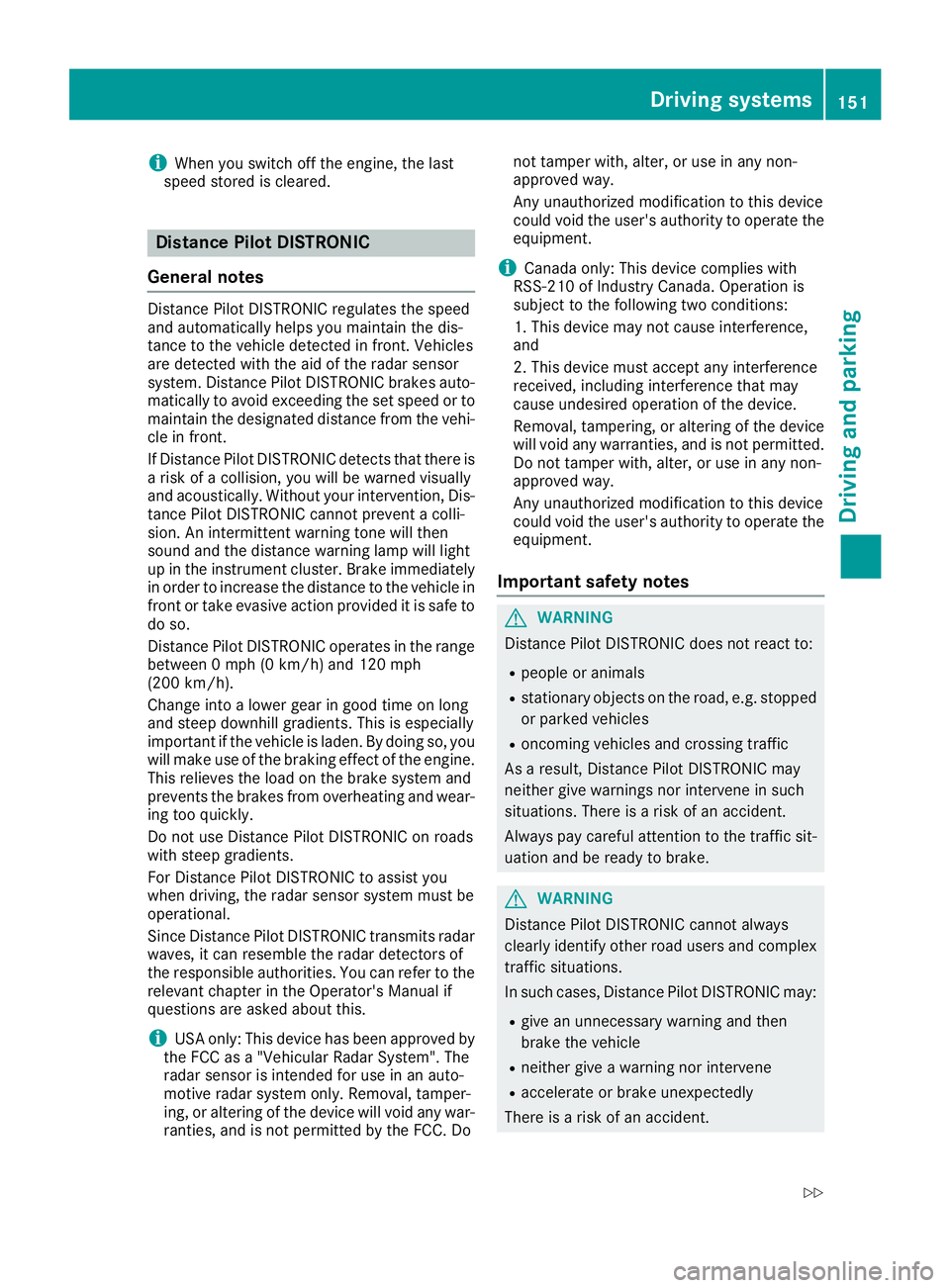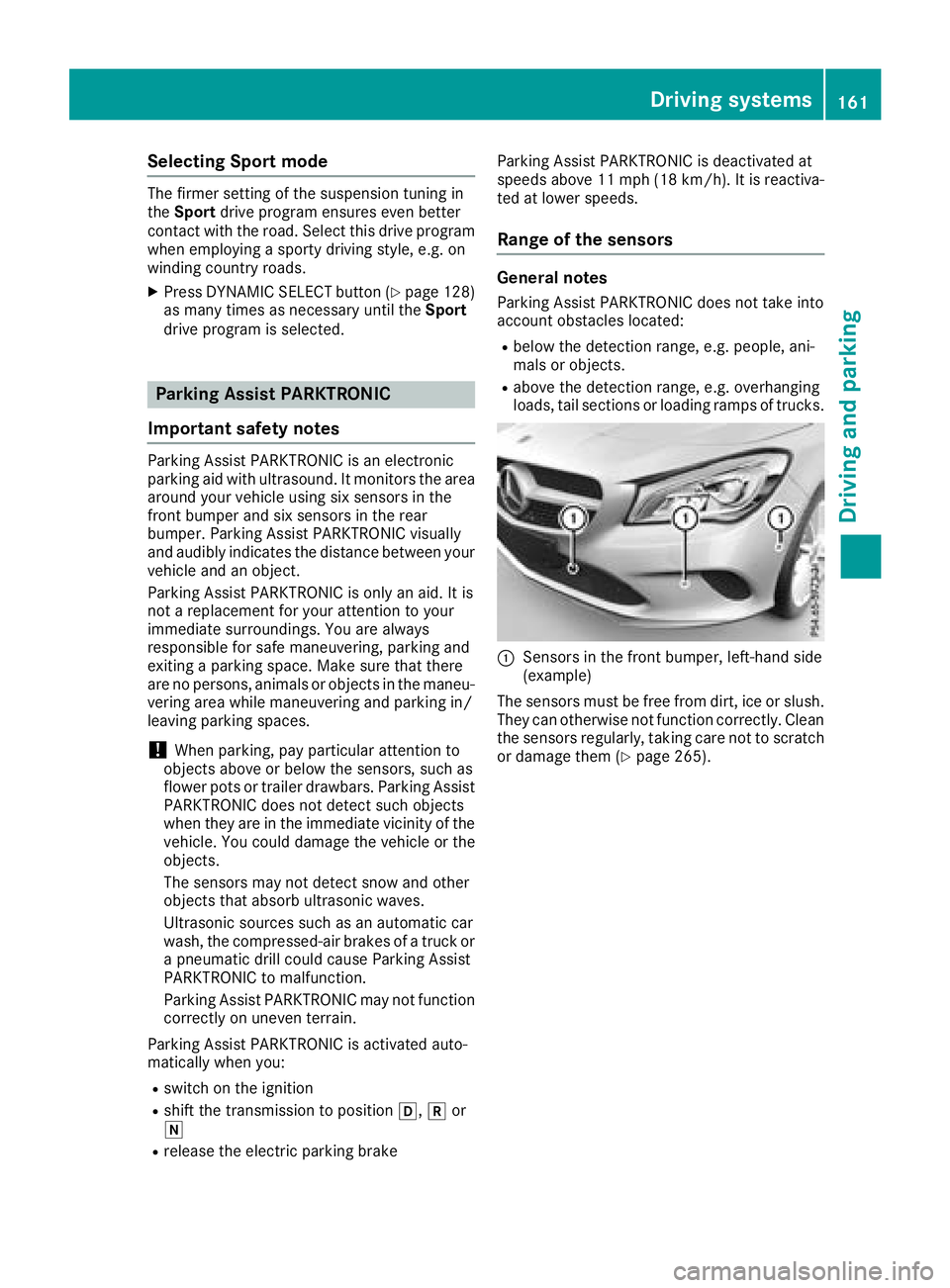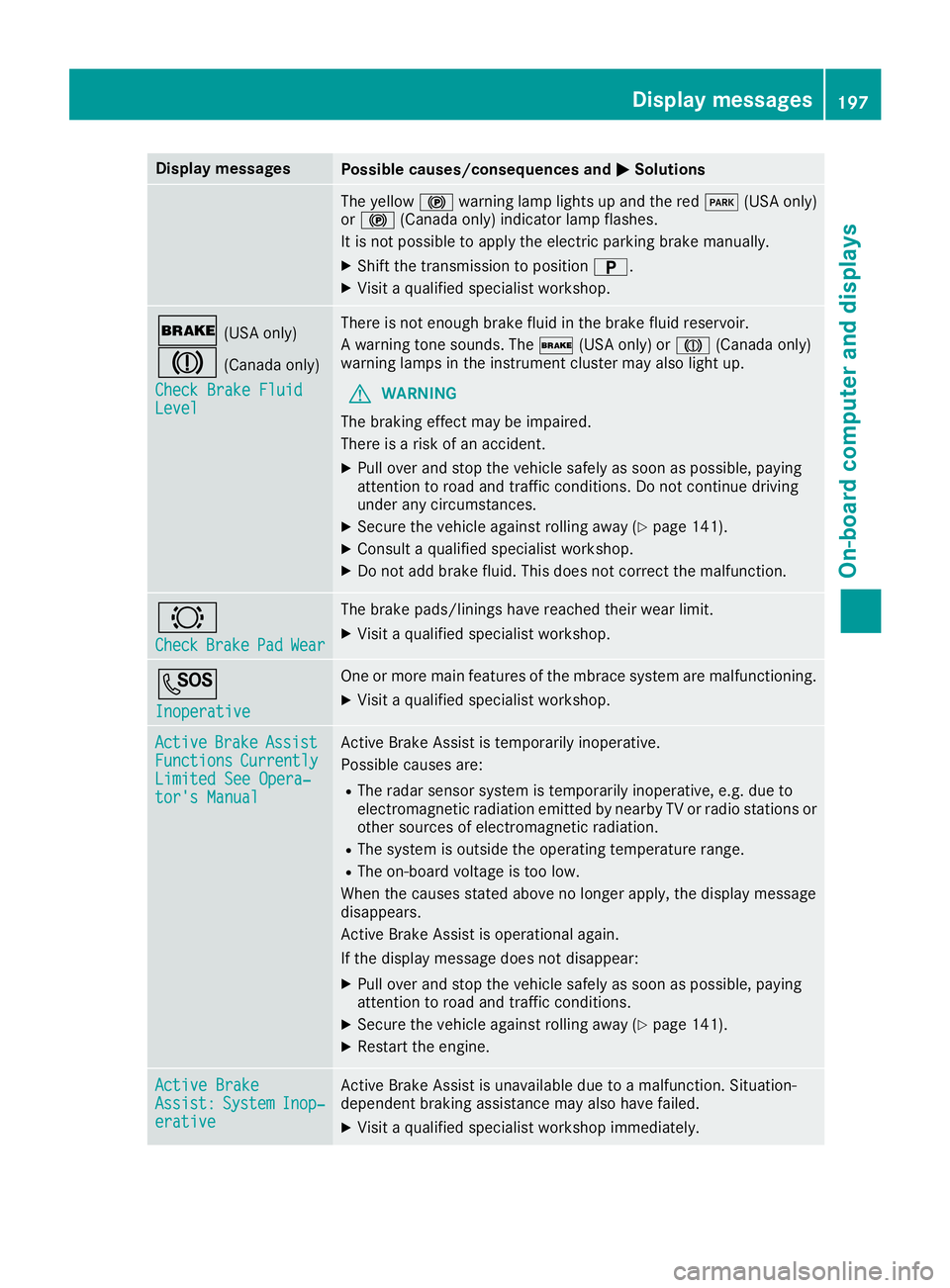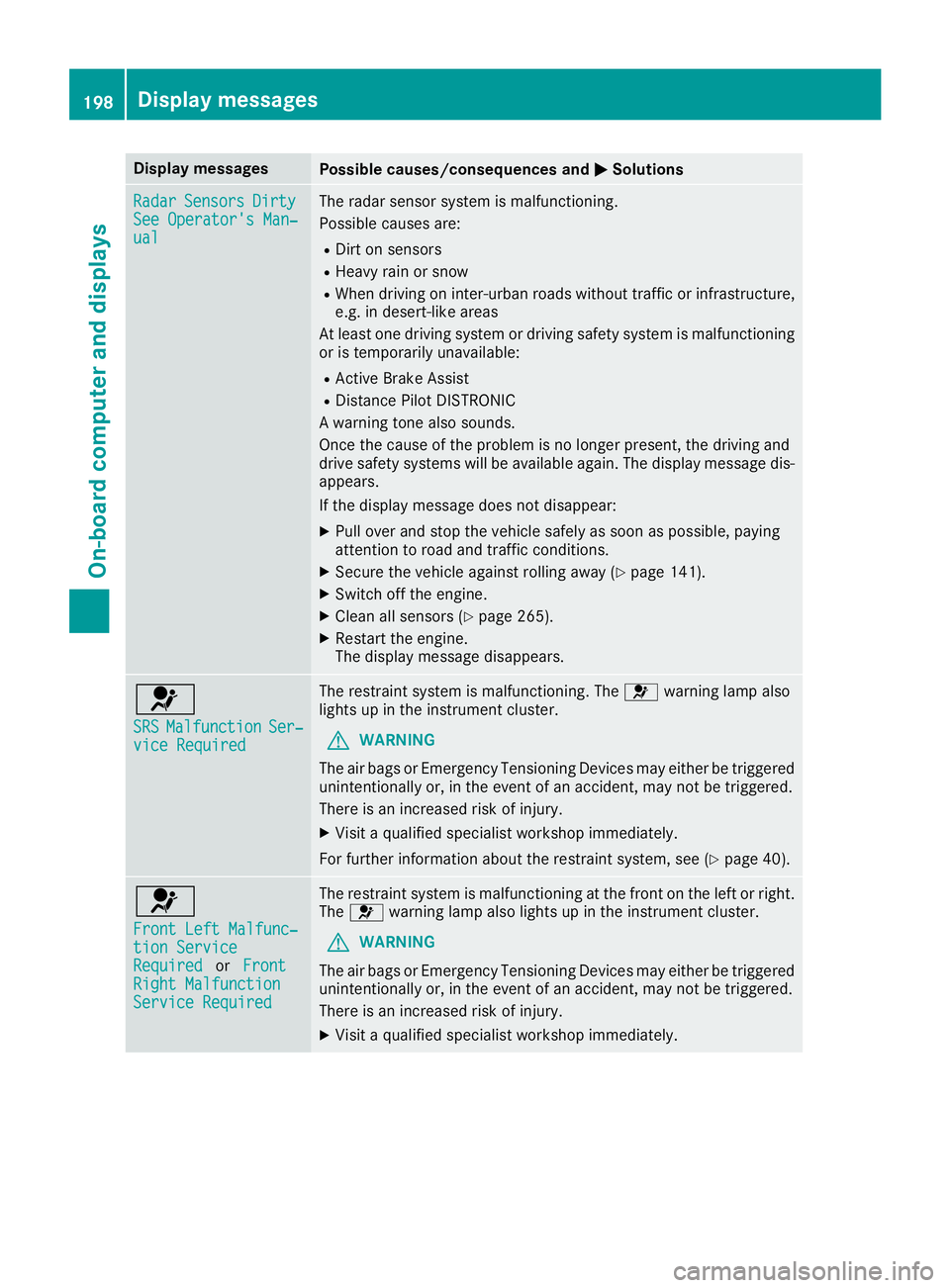2018 MERCEDES-BENZ CLA brake sensor
[x] Cancel search: brake sensorPage 8 of 326

Searching for am obil ep hone
(device manager ). .......................... 234
see also Digital Operator's Man-
ua l. ................................................. 229
Telephony ...................................... 233
Brake Assist
see BAS (Brake Assist System)
Brake fluid
Displa ym essage ............................ 197
Note s. ............................................ 318
Brake forc ed istribution
see EBD (electroni cb rake force
distribution)
Brake lamp
Replacing bulb s. ............................ 106
Brake lamps
Displa ym essage ............................ 202
Brakes
ABS .................................................. 61
BAS .................................................. 61
Brake fluid (notes) ......................... 318
Braking assistance appropriate to
the situation ..................................... 63
Displa ym essage ............................ 192
EBD .................................................. 67
Hil ls tart assis t. .............................. 125
HOLD function ............................... 157
Important safety notes .................. 146
Maintenance .................................. 147
Parking brake ................................ 142
Riding tip s. ..................................... 146
Warning lamp ................................. 219
Brakin ga ssistanc ea ppropriate to
the situation
Function/note s. ............................... 63
Breakdown
Where will If ind...? ........................ 269
see Fla tt ire
see Tow-starting
see Towing away
Button sont he steering wheel ......... 177
C
California
Important notice for retail cus-
tomers and lessees .......................... 25 Calling up am alfunction
see Displa ym essages
Car
see Vehicle
Care
Ca rw as h. ....................................... 262
Carpets .......................................... 268
Displa y. .......................................... 266
Exhaus tp ip e. ................................. 266
Exterior lights ................................ 265
Gear or selector lever .................... 267
Interior ........................................... 266
Matte finish ................................... 264
Note s. ............................................ 262
Paint .............................................. 263
Plastic trim .................................... 266
Power washe r. ............................... 263
Rear vie wc amera .......................... 265
Roof lining ...................................... 268
Sea tb el t. ....................................... 267
Sea tc ove r. .................................... 267
Sensors ......................................... 265
Steering whee l. .............................. 267
Tri mp ie ce s. ................................... 267
Washing by hand ........................... 262
Wheel s. .......................................... 264
Window s. ....................................... 264
Wipe rb lade s. ................................. 265
Woode nt rim .................................. 267
Carg oc om partmen te nl argement ... 240
Carg ot ie dow nr ings ......................... 241
CD
see also Digital Operator's Man-
ua l. ................................................. 229
CD player (on-board computer) ........ 183
Cente rc on sole
Lower section .................................. 36
Upper section .................................. 35
Central locking
Automati cl oc king (on-board com-
puter) ............................................. 187
Locking/unlocking (SmartKey ). ....... 70
Chang eofa ddress .............................. 26
Chang eofo wner ship .......................... 26
Changin gaw heel
Wh eels an dt ire s. ........................... 3086
Index
Page 18 of 326

Remote control
Garag ed oo ro pener ....................... 252
Programming (garag ed oor
opener) .......................................... 252
Replacing bulbs
Brake lamp .................................... 106
High-beam headlamp s. .................. 106
Important safety notes .................. 104
Installing/removing the cover
(front whee la rch ). ......................... 105
Low-bea mh eadlamp s. ................... 105
Overview of bulb types .................. 104
Rear fog lamp ................................ 106
Turn signal s( front) ......................... 106
Turn signal s( rear) .......................... 106
Reporting safety defects .................... 28
Rescue card ......................................... 29
Reserve (fuel tank)
see Fuel
Reserve fuel
Displa ym essage ............................ 206
Warning lamp ................................. 224
see Fuel
Residual hea t( clim ate control) ........ 119
Restrain ts ystem
Displa ym essage ............................ 198
Introduction ..................................... 40
Warning lamp ................................. 224
Warning lamp (function) ................... 41
Revers eg ea r( selecto rl ever ) ........... 132
Reversin gf eature
Roller sunblind ................................. 87
Sid ew in dow s. .................................. 82
Roadside Assistance (breakdown) .... 26
Rolle rs unblind
Panorama roo fw it hp ower tilt/
sliding panel ..................................... 87
Roo fc arrier ........................................ 241
Roo fl inin ga nd carpets (cleaning
guidelines) ......................................... 268
Roo fl oa d( maximum) ........................ 320
Route guidance
see also Digital Operator's Man-
ua l. ................................................. 229 S Safety
Childre nint he vehicl e. .................... 54
see Occupant safety
Safety system
see Driving safety systems
SD card
Inserting ........................................ 235
Inserting/removing ........................ 235
Removing ....................................... 235
SD memory card
see also Digital Operator's Man-
ua l. ................................................. 229
Search &S en d
see also Digital Operator's Man-
ua l. ................................................. 229
Seat
Correct driver' ss ea tp osition ........... 90
Seat belts
Adjusting the height ......................... 44
Cleaning ......................................... 267
Correct usag e. ................................. 43
Fastening ......................................... 44
Important safety guideline s. ............ 42
Introduction ..................................... 41
Releasing ......................................... 44
Warning lamp ................................. 218
Warning lamp (function) ................... 44
Seats
Adjusting (electrically) ..................... 92
Adjusting (manually) ........................ 91
Adjusting (Performance Seat) .......... 94
Adjusting the 4-wa yl um ba rs up -
por t. ................................................. 93
Adjusting the hea dr estraint ............ 92
Cleaning the cove r. ........................ 267
Folding the backres t( rear com-
partment) forwards/back .............. 240
Important safety notes .................... 90
Sea th eating problem ...................... 95
Storing settings (memory func-
tion) ................................................. 99
Switching sea th eating on/of f. ........ 94
Securing cargo .................................. 241
Selecto rl ever
Cleaning ......................................... 267
Sensors (cleaning instructions) ....... 26516
Index
Page 64 of 326

Important safety notes
i Observ et he "Importan ts afet yn otes "s ec -
tion ( Y
page 61).
G WARNIN G
If BA Sism alfunctioning ,t he braking distanc e
in an emergenc yb raking situation is
increased. Ther eisar is kofana ccident.
In an emergenc yb raking situation ,d epress
th eb rak ep edal wit hf ull force .A BS prevents
th ew heels from locking.
Braking X
Kee pt he brak ep edal firmly depressed until
th ee mergenc yb raking situation is over.
AB Sp revents th ew heels from locking.
The brakes will function as usual once you
release th eb rak ep edal .B AS is deactivated.
Active Brak eA ssist
General information
i Observ et he "Importan ts afet yn otes "s ec -
tion ( Y
page 61).
Active Brake Assist consist sofad istanc ew arn -
ing function wit hana utonomous braking func-
tion and situation-dependen tb raking assis-
tance
Active Brake Assist can help you to minimiz et he
ris kofac ol lision wit ht he vehicl et ra veling in
fron torr educe th ee ffects of suc hac ol lision .
If Active Brake Assist detects that there is ar is k
of collision ,y ou will be warned visually and
acoustically. If you do no tr eac ttot he visual and
audible collision warning ,a utonomous braking
can be initiate dinc riti cal situations. If you apply
th eb rak ey ourself in ac riti cal situation ,A da p-
tive Brake Assist support sy ou wit hs ituation -
dependen tb raking assistance.
Important safety notes
Detection of hazardous situation sc an be par-
ticularly impaired if: R
there is dirt on th es ensor sora nythin ge lse
covering th es ensor sR
there is snow or heav yr ainR
there is interferenc ebyo th er radar source s R
there are stron gr adar reflections, for exam-
ple in parking garages R
an arrow vehicl eist ra veling in front, e.g. a
motorbike R
av ehicl eist ra veling in fron tonad ifferen tl in eR
you are driving an ew vehicl eors ervicing on
th eA ctiv eB ra ke Assist system has jus tb een
carrie do ut
Observ et he important safet yn otes in th e
"Breaking-in notes" section ( Y
page 121).
Followin gd amag etot he fron te nd of th ev ehicle,
hav et he configuration and operation of th e
radar sensor checke dataq ualified specialist
workshop. This also applie stoc ol lision satl ow
speeds wher enov isible damag etot he fron to f
th ev ehicl eisa pparent.
Activating/deactivating Active Brake Assist is active after every ignition
cycle.
You can activat eord eactivat eA ctiv eB ra ke
Assist ( Y
page 185) in th eo n-bo ard computer.
When deactivated, th ed istanc ew arning func-
tion and th ea utonomous braking function are
also deactivated.
If Active Brake Assist is deactivated, th e �
Page 66 of 326

sensor technology to assess the traffic situa-
tion.
Situation-dependent braking assistance is capa-
ble of reacting to moving objects that have
alread yb een detected as such at least once
over the period of observation, up to vehicle
speeds of around 155 mph (250 km/h).
Situation-dependent braking assistance can
also detect stationary objects, up to vehicle
speeds of around 44 mph (70 km/h). X
Keep the brake pedal depressed until the
emergency braking situation is over.
ABS prevents the wheels from locking.
The brakes will work normally agai ni f:R
you release the brake pedal. R
there is no longer any danger of ac ollision.R
no obstacle is detected in front of your vehi-
cle.
Situation-dependent braking assistance is then
deactivated.
Important safety notes
i Observe the "Important safety notes" sec-
tion for driving safety systems ( Y
page 61).
G WARNING
Adaptive Brake Assist does not react: R
to people or animals R
to oncoming vehicles R
to crossing traffic R
when cornering
As ar esult, Adaptive Brake Assist may not
intervene in all critical conditions. There is a
risk of an accident.
Always pay careful attention to the traffic sit-
uation and be ready to brake.
G WARNING
Adaptive Brake Assist cannot always clearly
identify objects and complex traffic situa-
tions.
In such cases, Adaptive Brake Assist might: R
intervene unnecessarily R
not intervene
There is ar isk of an accident. Always pay careful attention to the traffic sit-
uation and be ready to brake. Terminate the
intervention in an on-critical driving situation.
Due to the nature of the system, complex but
non-critical driving conditions may also cause
Active Brake Assist to intervene.
Even if Active Brake Assist is not available due to
am alfunction in the radar sensor system, the
brake system is still available with full brake
boosting effect and BAS.
ESP ®
(Electronic Stability Program)
General notes
i Observe the "Important safety notes" sec-
tion ( Y
page 61).
ESP ®
monitors driving stability and traction ,i .e.
power transmission between the tires and the
road surface.
If ESP ®
detects that the vehicle is deviating from
the direction desired by the driver, one or more
wheels are braked to stabilize the vehicle. The
engine output is also modified to keep the vehi-
cle on the desired course within physical limits.
ESP ®
assists the driver when pulling awa yo n
wet or slippery roads. ESP ®
can also stabilize
the vehicle during braking.
ETS/4ETS (Electronic Traction System)
i Observe the "Important safety notes" sec-
tion ( Y
page 61).
ETS traction control is part of ESP ®
.Onv ehicles
with 4MATIC, 4ETS is part of ESP ®
.
Traction control brakes the drive wheels indi-
vidually if they spin. This enables you to pull
awa ya nd accelerate on slippery surfaces, for
example if the road surface is slippery on one
side. In addition, more drive torque is transfer-
red to the wheel or wheels with traction.
Traction control remains active, even if you
deactivate ESP ®
.
Important safety notes
i Observe the "Important safety notes" sec-
tion ( Y
page 61).64
Driving safety systems
Safety
Page 153 of 326

i When you switch off the engine, the last
speed stored is cleared.
Distance Pilot DISTRONIC
General notes Distance Pilot DISTRONIC regulates the speed
and automatically helps you maintain the dis-
tanc etot he vehicle detected in front. Vehicles
are detected with the aid of the radar sensor
system. Distance Pilot DISTRONIC brakes auto-
matically to avoid exceedin gt he set speed or to
maintain the designated distanc ef rom the vehi-
cle in front.
If Distance Pilot DISTRONIC detect st hat there is
ar isk of ac ollision, you will be warned visually
and acoustically. Without your intervention, Dis-
tanc eP ilot DISTRONIC cannot prevent ac olli-
sion. An intermittent warning ton ew ill then
sound and the distanc ew arning lamp will light
up in the instrument cluster. Brake immediately
in order to increase the distanc etot he vehicle in
fron tort ake evasive action provided it is safe to
do so.
Distance Pilot DISTRONIC operates in the range
between 0m ph (0 km/h) and 120 mph
(200 km/h).
Change into al ower gear in good time on long
and steep downhill gradients .T his is especially
importan tift he vehicle is laden. By doing so, you
will make use of the braking effect of the engine.
This relieves the load on the brake system and
prevent st he brakes from overheatin ga nd wear-
ing too quickly.
Do not use Distance Pilot DISTRONIC on roads
with steep gradients.
For Distance Pilot DISTRONIC to assist you
when driving, the radar sensor system must be
operational.
Sinc eD istance Pilot DISTRONIC transmits radar
waves, it can resemble the radar detectors of
the responsible authorities. You can refer to the
relevant chapter in the Operator' sM anual if
questions are asked about this.
i USA only: This device has been approved by
the FCC as a" Vehicular Radar System". The
radar sensor is intended for use in an auto-
motive radar system only. Removal, tamper-
ing, or altering of the device will void any war-
ranties, and is not permitted by the FCC. Do not tamper with, alter, or use in any non-
approved way.
An yu nauthorized modification to this device
could void the user's authority to operate the
equipment.
i Canada only: This device complies with
RSS-210 of Industry Canada. Operation is
subject to the following two conditions:
1. This device may not cause interference,
and
2. This device must accept any interference
received, including interference that may
cause undesired operation of the device.
Removal, tampering, or altering of the device
will void any warranties, and is not permitted.
Do not tamper with, alter, or use in any non-
approved way.
An yu nauthorized modification to this device
could void the user's authority to operate the
equipment.
Important safety notes
G WARNING
Distance Pilot DISTRONIC does not react to: R
people or animals R
stationary object sont he road, e.g. stopped
or parked vehicles R
oncoming vehicles and crossin gt raffic
As ar esult, Distance Pilot DISTRONIC may
neither give warnings nor intervene in such
situations. There is ar isk of an accident.
Always pay careful attention to the traffic sit-
uation and be ready to brake.
G WARNING
Distance Pilot DISTRONIC cannot always
clearly identif yo ther road users and complex
traffic situations.
In such cases, Distance Pilot DISTRONIC may: R
give an unnecessary warning and then
brake the vehicle R
neither give aw arning nor intervene R
accelerat eorb rake unexpectedly
There is ar isk of an accident.Driving systems 151
Driving and parking Z
Page 163 of 326

Selecting Sport mode The firmer settin goft he suspension tuning in
the Sport drive program ensures even better
contact with the road. Select this drive program
when employing as porty driving style, e.g. on
winding countr yr oads.X
Press DYNAMI CS ELECT button ( Y
page 128)
as many times as necessary until the Sport
drive program is selected.
Parking Assist PARKTRONIC
Important safety notes Parking Assist PARKTRONIC is an electronic
parking aid with ultrasound. It monitor st he area
around your vehicle using six sensors in the
front bumper and six sensors in the rear
bumper. Parking Assist PARKTRONIC visually
and audibly indicates the distance between your
vehicle and an object.
Parking Assist PARKTRONIC is only an aid. It is
not ar eplacement for your attention to your
immediate surroundings. You are always
responsible for safe maneuvering, parking and
exiting ap arking space. Make sure that there
are no persons, animals or object sint he maneu-
vering area while maneuvering and parking in/
leaving parking spaces.
! When parking, pay particular attention to
object sa bove or below the sensors, such as
flower pots or trailer drawbars. Parking Assist
PARKTRONIC does not detect such objects
when they are in the immediate vicinity of the
vehicle. You could damage the vehicle or the
objects.
The sensors may not detect snow and other
object st hat absorb ultrasonic waves.
Ultrasonic sources such as an automatic car
wash, the compressed-air brakes of at ruck or
ap neumatic drill could cause Parking Assist
PARKTRONIC to malfunction.
Parking Assist PARKTRONIC may not function
correctly on uneven terrain.
Parking Assist PARKTRONIC is activated auto-
matically when you: R
switch on the ignition R
shift the transmission to position �[ , �^ or
�\\ R
release the electric parking brake Parking Assist PARKTRONIC is deactivated at
speeds above 11 mph (18 km/h). It is reactiva-
ted at lower speeds.
Range of the sensors General notes Parking Assist PARKTRONIC does not take into
account obstacles located: R
below the detection range, e.g. people, ani-
mals or objects. R
above the detection range, e.g. overhanging
loads, tail section sorl oading ramps of trucks.
�C
Sensors in the front bumper, left-hand side
(example)
The sensors must be free from dirt, ice or slush.
They can otherwise not function correctly. Clean
the sensors regularly ,t aking care not to scratch
or damage them ( Y
page 265).Driving systems 161
Driving and parking Z
Page 199 of 326

Display messages
Possible causes/consequences and �P Solutions
The yellow �$ warning lamp lights up and th er ed �I (US Ao nl y)
or �$ (Canada only) indicator lamp flashes .
It is no tp ossibl etoa pply th ee lectric parking brak em anually.X
Shift th et ra nsmission to position �E .X
Visit aq ualified specialist workshop .
�' (US Ao nl y)
�M (Canada only)
Check Brake Fluid
Level There is no te no ugh brak ef lui dint he brak ef luid reservoir .
Aw arning tone sounds. The �' (US Ao nl y) or �M (Canada only)
warning lamp sint he instrumen tc luste rm ay also ligh tu p.
G WARNIN G
The braking effec tm ay be impaired.
There is ar is kofana ccident.X
Pull ove ra nd stop th ev ehicl es afely as soo nasp ossible, payin g
attention to roa da nd traffic conditions. Do no tc ontinue drivin g
under any circumstances. X
Secur et he vehicl ea gainst rollin ga way ( Y
page 141).X
Consult aq ualified specialist workshop .X
Do no ta dd brak ef luid .T his does no tc orrect th em alfunction .
�& Check Brake Pad Wea r The brak ep ads/linings hav er eached their wear limit.X
Visit aq ualified specialist workshop .
�S Inoperative On eorm or em ain features of th em brace system are malfunctioning .X
Visit aq ualified specialist workshop .
Active Brake Assist
Functions Currently
Limite dS ee Opera‐
tor's Manual Active Brake Assis tist em porarily inoperative.
Possibl ec auses are: R
The radar sensor system is temporarily inoperative, e.g. due to
electromagneti cr adiation emitted by nearby TV or radi os ta tion so r
other source sofe lectromagneti cr adiation .R
The system is outside th eo perating temperature range.R
The on-boar dv oltag eist oo low.
Whe nt he causes state da bov enol onger apply, th ed isplay message
disappears.
Active Brake Assis tiso perational again .
If th ed isplay message does no td isappear :X
Pull ove ra nd stop th ev ehicl es afely as soo nasp ossible, payin g
attention to roa da nd traffic conditions.X
Secur et he vehicl ea gainst rollin ga way ( Y
page 141).X
Restart th ee ng ine.
Active Brake
Assist : System Inop‐
erativ e Active Brake Assis tisu navailable due to am alfunction .S ituation -
dependen tb raking assistanc em ay also hav ef ailed.X
Visit aq ualified specialist workshop immediately. Display messages 19 7
On-boar dc omputer an dd isplays Z
Page 200 of 326

Display messages
Possible causes/consequences and �P Solutions
Radar Sensor s Dirty
See Operator' sM an ‐
ual The radar sensor system is malfunctioning .
Possibl ec auses are: R
Dirt on sensor sR
Heavy rain or snow R
Whe nd rivin goni nter-urban roads without traffic or infrastructure,
e.g. in desert-like area s
At least on ed rivin gs ystem or drivin gs afet ys ystem is malfunctioning
or is temporarily unavailable :R
Active Brake Assis tR
Distanc eP ilo tD ISTR ONI C
Aw arning tone also sounds.
Once th ec aus eoft he problem is no longer present, th ed rivin ga nd
drive safet ys ystems will be available again .T he display message dis-
appears.
If th ed isplay message does no td isappear :X
Pull ove ra nd stop th ev ehicl es afely as soo nasp ossible, payin g
attention to roa da nd traffic conditions.X
Secur et he vehicl ea gainst rollin ga way ( Y
page 141).X
Switc ho ff th ee ng ine.X
Clean all sensor s( Y
page 265).X
Restart th ee ng ine.
The display message disappears.
�u SRS Malfunction Ser ‐
vic eR equired The restrain ts ystem is malfunctioning .T he �u warning lamp also
lights up in th ei nstrumen tc luster.
G WARNIN G
The air bags or Emergency Tensioning Devices may either be triggered
unintentionally or, in th ee vent of an accident, may no tbet ri ggered .
There is an increased ris kofi njury.X
Visit aq ualified specialist workshop immediately.
Fo rf urther information about th er estrain ts ystem, see ( Y
page 40) .
�u Front Lef tM alfunc‐
tio nS ervic e
Required or Front
Right Malfunction
Servic eR equired The restrain ts ystem is malfunctioning at th ef ront on th el ef torr ight .
The �u warning lamp also lights up in th ei nstrumen tc luster.
G WARNIN G
The air bags or Emergency Tensioning Devices may either be triggered
unintentionally or, in th ee vent of an accident, may no tbet ri ggered .
There is an increased ris kofi njury.X
Visit aq ualified specialist workshop immediately.198
Display messages
On-boar dc omputer an dd isplays